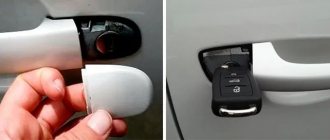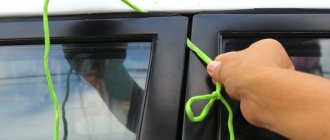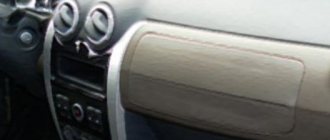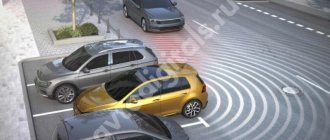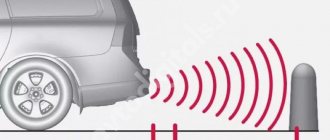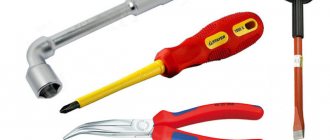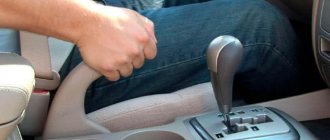Hello, friends! Any motorist can get into an accident or become involved in an accident. This does not depend 100% on experience, skills, and the ability to make quick decisions in difficult situations. Interestingly, reversing out of a parking lot often causes a collision.
The number of accidents in parking lots and parking lots is impressive. At the same time, when faced with a collision on a regular road, drivers usually know how to act. If the situation occurs in a parking lot (parking lot), then the participants are lost.
Distances are short, there are many vehicles. It's hard to keep track of everything going on around you. According to statistics, it is when you back out of a parking lot that the largest number of accidents occur.
Where to begin
When reversing onto the roadway, or into an area not occupied by cars, the driver may get into an accident.
In general, the words road accident, reversing and who is to blame are heard very often on various thematic forums and websites.
The parking lot isn't the only place where this happens. You can drive backwards into someone in the yard, in the parking lot, as well as in parking lots and other areas with limited space for a safe turn.
If you find yourself in such a situation, you must:
- don't start panicking;
- stop to prevent further damage;
- turn on the emergency lights;
- put an emergency sign on the road;
- if there are victims, call an ambulance;
- call the traffic police squad.
Practice, as well as the rules for leaving a parking lot in reverse, show that in most cases the driver of a vehicle moving in reverse gear is at fault. This is due to the fact that when maneuvering, the motorist must first make sure that the action being performed is safe.
Difference between stopping and parking
According to paragraph 1.2 of the Russian Traffic Regulations, the law distinguishes between stopping and parking. For example, if you stop driving for up to 5 minutes (or more if necessary to board or disembark passengers or load or unload a vehicle), it is considered a stop. If the cessation of movement occurs for more than 5 minutes for reasons not related to boarding/disembarking or loading/unloading of the car, then this is considered parking.
See also: This is why you can’t park in guest pockets in courtyards
“
Stop ” is a deliberate stop in the movement of a vehicle for up to 5 minutes, as well as for longer if this is necessary for boarding or disembarking passengers or loading or unloading a vehicle. “ Parking ” is the intentional cessation of movement of a vehicle for a period of more than 5 minutes for reasons not related to the embarkation or disembarkation of passengers or the loading or unloading of the vehicle.
What are the rules?
Now you need to understand the rules that apply to leaving the parking lot. To be more precise, this is leaving a parking lot in reverse.
Drivers have the following chain: leaving the parking lot - accident - who is to blame.
The current rules say that driving in reverse gear is permitted in a situation where the maneuver is safe and will not create problems for other road users.
But if an accident occurs in a parking lot, who is to blame? The one who was driving back.
Yes, other drivers, as well as road users, can potentially be held accountable. For example, if the second car was speeding. But even here, both drivers will be held accountable.
It is important to take into account that an accident does not provide any relief in the event that the motorist who made a reverse collision or created an emergency situation was prevented by factors beyond his control. For example, bad weather or low visibility due to insufficient street lighting.
Learning direct parking
This is a very simple and necessary method in the city. Here the car is parked along something in a straight line. If you decide to park this way, you don't need to drive too close to the objects in front of you.
Also don't forget about the doors. Pay attention to obstacles near your doors. When parking straight ahead, approach the car in front of you as close as possible to 1.5 m. Then start moving towards the curb.
Before the front wheels reach the curb 0.5 m, turn the car to the left. Then level off. This requires precise control skills. Focus on the dimensions of the car in front of you.
Also consider safe departure.
How to act
For some motorists, getting out of the parking lot onto the road causes certain difficulties.
There are some useful recommendations in this regard:
- if you cannot assess the situation on your own when leaving, ask for help from a passenger or a random passer-by;
- the help of another person will allow you to drive out safely and also give signals to other drivers;
- It’s better not to back up if the weather is bad;
- It is also not recommended to engage reverse gear when there is low visibility outside.
But there is also a universal recommendation that helps quite often.
Yes, it is important to understand that parking arrangements do not always allow this.
But objectively, the best solution would be to park in such a way that when leaving, the driver is required to drive forward. In other words, you should park in reverse. This will allow you to drive forward, in forward gear, and thereby minimize the likelihood of a collision with other road users in the parking area.
How to reverse out of a parking lot between cars correctly
We are practicing a skill that a car owner cannot do without in the urban jungle. But it’s a little different from what they teach in driving school.
Many drivers without experience panic when they find themselves in such situations. After all, by the time you get out of the “grip,” you’ll sweat seven times so as not to inadvertently hit some kind of car. And, as luck would have it, there are “millionaires’ cars” all around.
Of course, if you prepare at the very beginning and drive into a parking space backwards, then getting out will be much easier: the entire view is open, and you won’t need much room for maneuvers. But there is not always time for such actions, and it is more convenient to unload shopping bags when the car is parked in the trunk to leave.
In this case, you need to thoroughly master the skill of driving backwards and practice it until you perform it confidently.
In a driving school they teach you to first drive as far back as possible, and only then start turning the steering wheel and setting the angle of rotation. But this way you practically leave yourself no room for action and can “hook” all your neighbors. It is better to immediately rebuild into a more advantageous position.
MZSA 817701: modifications, technical characteristics, reviews
As many motorists probably know, driving in reverse according to the current rules is prohibited if it:
- crossroads;
- bridge;
- tunnel;
- crosswalk;
- railroad crossing;
- bus stop;
- area with poor visibility;
- highway.
As you can see, there is no question of parking here. And this is quite logical.
Punishment follows only if the driver’s actions in reverse led to a collision, as well as the need to register an accident. This can be done using the European protocol if the amount of damage is less than 100 thousand rubles. Or you will need to call the police.
According to the current rules, for violations of the rules of maneuvering, which specifically includes driving backwards from a parking lot, the culprit driver is forced to pay only 500 rubles.
It’s just important to take into account the fact that it will cover the cost of repairing the damaged car.
Reverse parking - pros and cons
But first, let's figure it out - what are the advantages and disadvantages of this parking method?
Let's start with the cons, since they are the most obvious and scary. Of course, this is an inconvenience for parking. Parking a car backwards is a matter that you need to learn, get used to the dimensions of the car, its turning angle, and so on. This also includes the fear of damaging someone’s car, or, in the end, your own.
But there is one more disadvantage, although it is more local. Since a large proportion of car owners park their car in front rather than in back, winter conditions create not the most favorable conditions for car owners who often warm up their cars. The fact is that in this case, in that part of the parking space where the front of the car is usually located, a layer of snow grows and its level becomes higher relative to the place where the rear of the car is usually located.
That is, in the case of parking backwards into such a parking space, it turns out that the car’s exhaust pipe is facing upward. This is detrimental because in this position condensate (that is, ordinary water) will accumulate in the pipe of the vehicle’s exhaust system, which is obtained as a result of the process of fuel combustion and exhaust gas purification. And at one fine moment, all this beauty may freeze, thereby blocking the exhaust channel. The consequences can be very sad and costly.
The benefits of reverse parking are mainly your safety. Think for yourself - which is easier to get out of a parking space, front or back? In front of course! In this case, you get an excellent overview and clearly understand the situation that is happening outside your car.
Another advantage is the development of driving skills. Once you learn how to reverse park, you will probably be able to parallel park without any problems very soon, and these skills are very valuable for any driver. In general, the car owner learns to feel his car, its dimensions, and understand its behavior.
Correct adjustment of car mirrors
Before parking when reversing, you should first learn how to adjust the mirrors. Everyone sets it up differently. Some people deliberately lower the mirror to observe part of the rear wheel. This allows you to avoid accidental collisions with various obstacles.
It is ideal if each mirror is adjusted. In the mirror located in the cabin, the entire rear window with its lower edge should be visible, and in the side mirrors - the part of the body behind and the surrounding environment.
Where parallel parking skills are needed
This method of parking is a helper in conditions of urban use and an acute shortage of free space. The ability to park the car correctly allows you to take a seat even in conditions of limited space.
In addition, parallel parking is one of the mandatory exercises when passing your license (we wrote about this above).
A couple of tips for a snack
When parking behind a car, do not forget to leave enough free space in front of you to freely leave the parking lot if it is not possible to reverse. Strictly ensure that you maintain a distance from nearby cars when parking crosswise! The most optimal distance between neighboring cars should be equal to the width required for free opening of the driver or passenger door of the car. Otherwise, opening the door may damage a car parked next door. Be careful when approaching the edge of the sidewalk. Lack of proper distance between it and your car can cause it to hit the curb or other nearby objects.
We hope that the above material will allow you to more quickly master the skill of proper parking. The absence of haste and fear will serve you well in this difficult task and will allow you to easily and easily cope with any complex maneuver.
